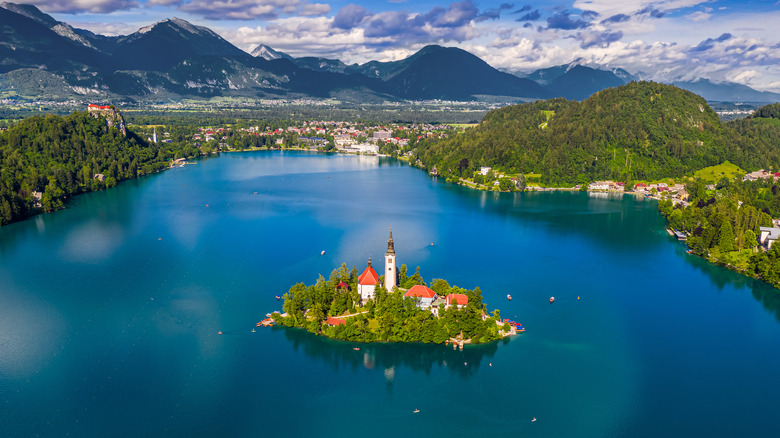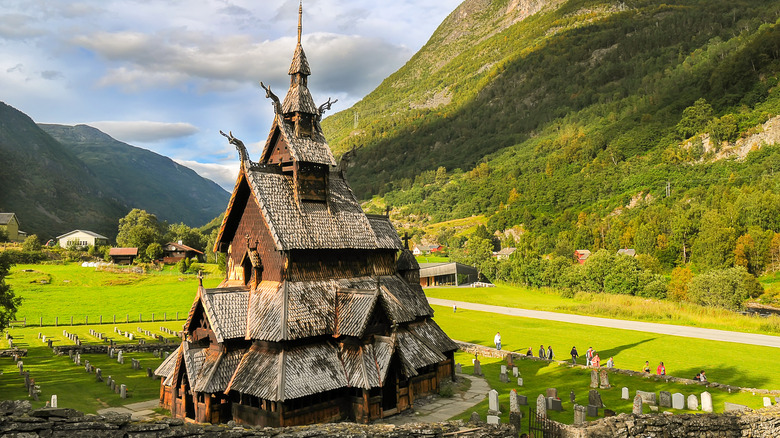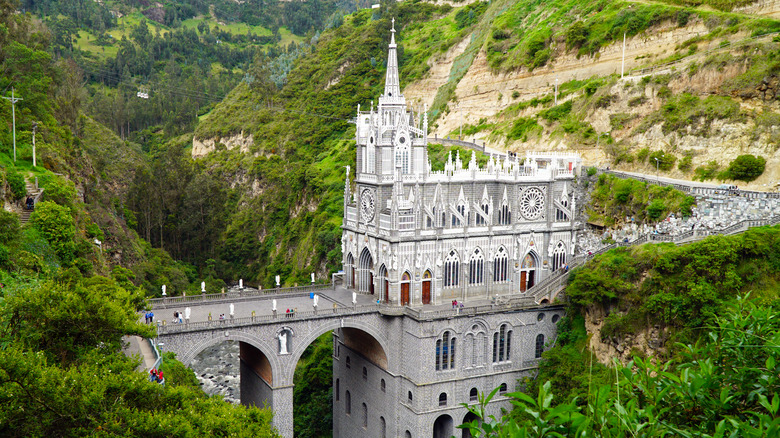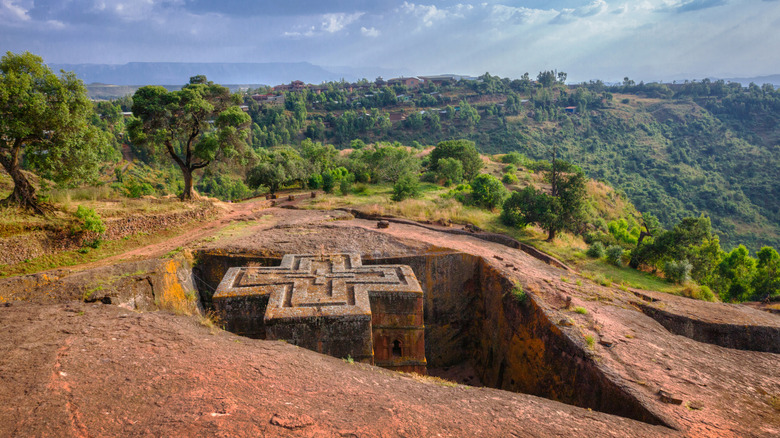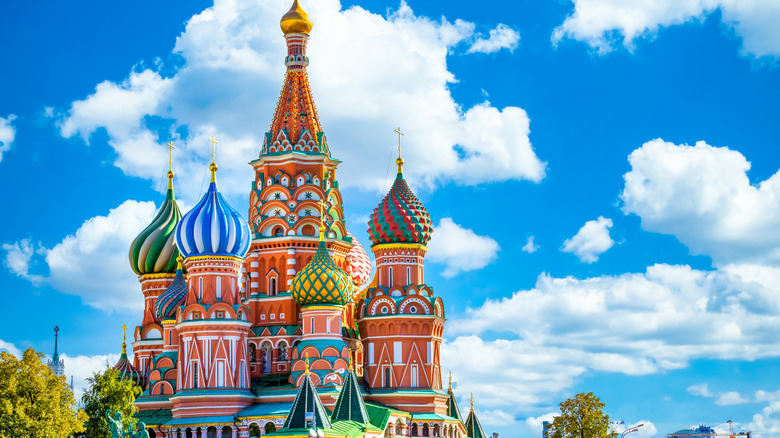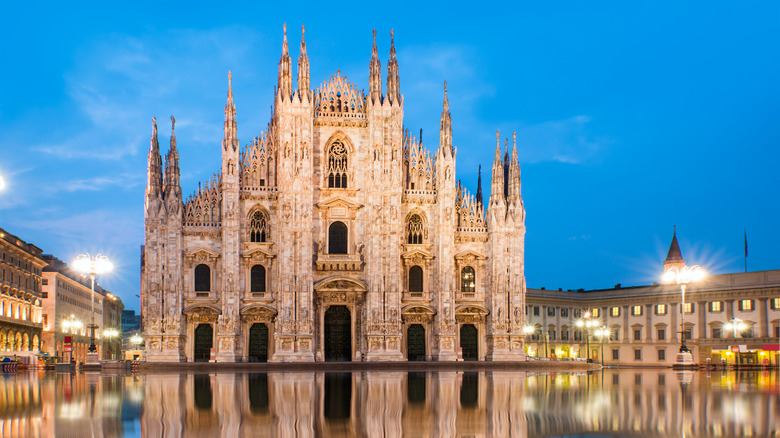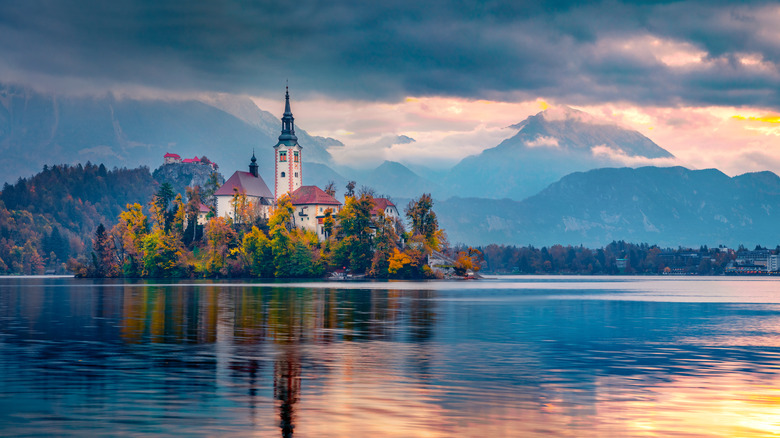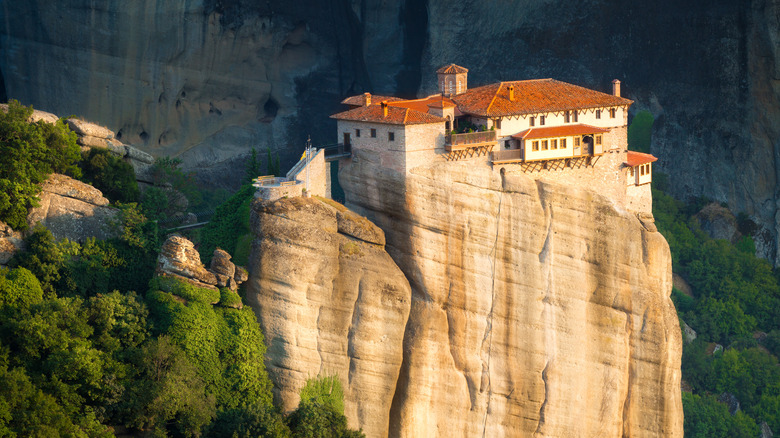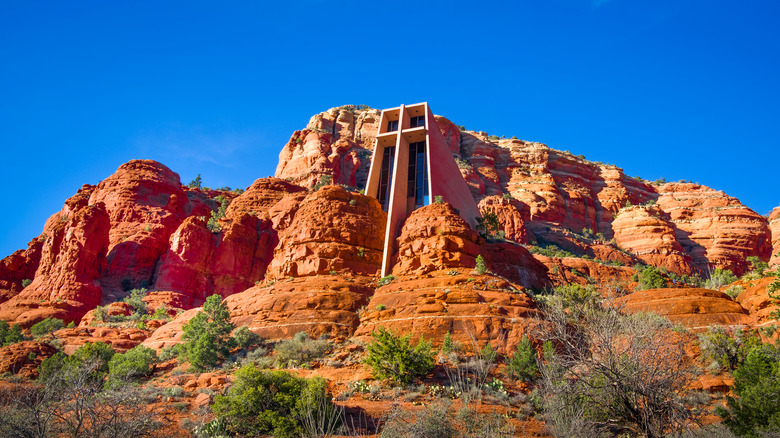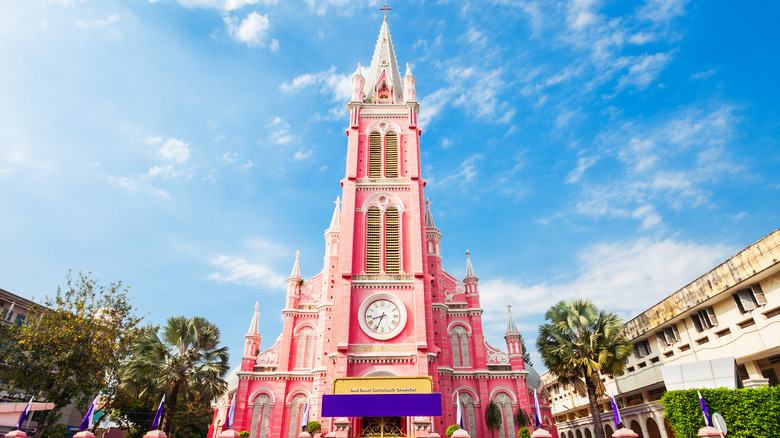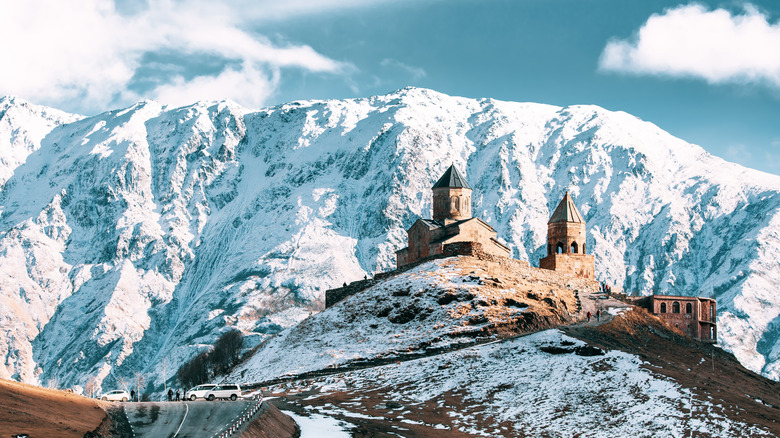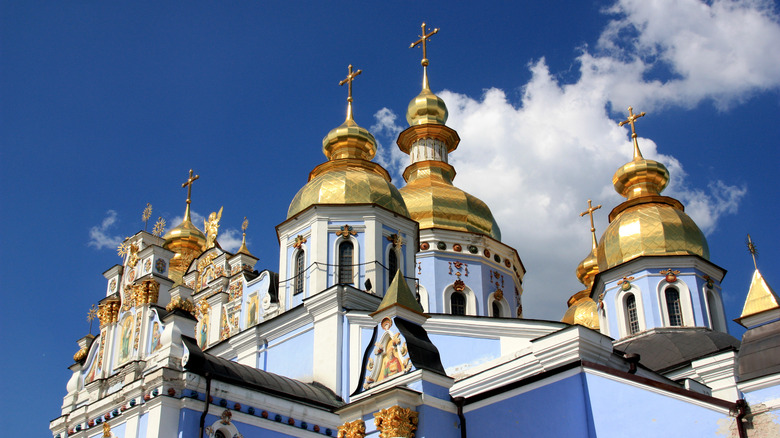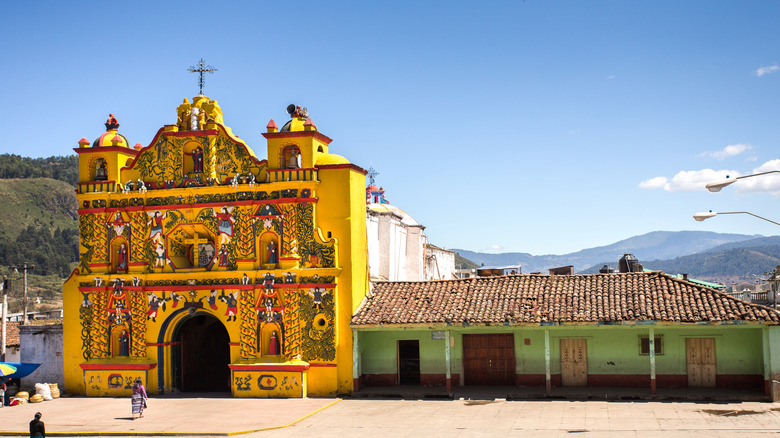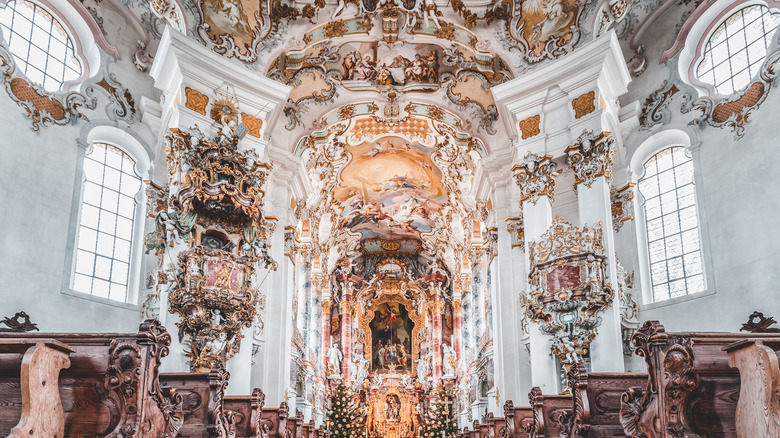The Most Stunning Churches Around The World
Few things are as soothing as stepping inside a beautiful church. Humans have been gathering in these houses of worship for thousands of years to pray, celebrate, and commemorate the past, per The Travel. Regardless of one's faith, the experience of visiting these breathtaking buildings provides a feeling of peace and connection. Not only are they often masterful examples of architecture, but they also contain rich history, stunning artwork, and one-of-a-kind sights — not to mention that they are usually one of the oldest parts of a city or region. Perhaps this is why the majority of travelers make a point to include these sacred spaces on their itineraries.
Whether it's an ancient wooden church in Norway or an imposing marble cathedral in Italy, it's hard not to be mesmerized by exquisite churches. With that in mind, we are taking a look at some of the most beautiful churches from all around the world.
Borgund Stave Church is one of Norway's architectural treasures
Originally built around 1180, the Borgund Stave Church is one of Norway's most important treasures and a fine example of medieval architecture. A particularly distinct detail is the four carved dragon heads on the gables of the roof. Inside you'll find a mid-16th century pulpit, along with an exhibition of Viking history and artifacts. The church's unique aesthetic reflects the conflict between Christianity and the pagan Viking religion taking place in Norway during the 12th century, according to Norway Today.
Once upon a time stave churches were all over Scandinavia, with archaeologists estimating there were around 2,000 in northwestern Europe hundreds of years ago. The churches were made out of wood and constructed with staves, which are load-bearing posts held up by strong vertical columns. However, today there are less than 30 of these churches and most of them can be found in western Norway. Thanks to the careful work of conservators, Borgund Stave Church is one of the best preserved examples left standing.
Las Lajas Sanctuary in Colombia is a place of miracles
Perched inside a forested canyon, Las Lajas Sanctuary straddles the border of Columbia and Ecuador in a one-of-a-kind setting. The impressive church rises over 150 feet above the river and overlooks a rushing waterfall and rolling green hills. Construction of the religious site began in 1916, inspired by two miracles that took place in the area, per MasterClass.
According to legend, a woman and her daughter sought sanctuary in the gorge during a dangerous storm. While taking shelter, the woman heard a voice. As she looked around trying to see where it was coming from, a vision of the Virgin Mary appeared from up above. At precisely this moment, the daughter was able to hear and speak for the first time in her life. The second miracle involves a blind man who traveled around the country for 10 years asking for donations to fund the Las Lajas chapel. Once he returned to Las Lajas, his sight suddenly returned. Today, the Gothic Revival church is a popular pilgrimage site and opens its doors to over 750,000 visitors annually.
The Church of St. George in Ethiopia is made entirely of volcanic rock
During the 12th century, Ethiopia's King Lalibela began to build "a New Jerusalem" in a mountainous region of the country. Muslim conquests had put a stop to Christian pilgrimages to the Holy Land, inspiring the king to create Ethiopia's own version. In total, 11 monolithic churches were built during the massive project. Each church was carved entirely from stone found on site, including windows, doors, columns, and other details.
St. George is one of the most well-known churches of the settlement and remains a place of religious significance to this day, per Brilliant Ethiopia. From a bird's eye view the structure might look like a simple cross, but the entire monolith actually stands at a whopping 30 meters. 3,400 meters of volcanic rock were used to complete the exterior alone. According to legend, upon the building's completion, angels blessed the site and the marks of St. George's horse are still visible in the surrounding rock face. A series of underground tunnels and passageways connect the church to the rest of the settlement.
St. Basil's Cathedral is named after a 'fool'
Located in Moscow's Red Square, St. Basil's Cathedral brightens up the skyline with a whimsical mix of colors and patterns. The church is named after Basil, a common Moscow cobbler who eventually became recognized for his prophetic powers and being a "fool for Christ." The building, which is also commonly referred to as Pokrovsky Cathedral, has witnessed many key historical and political events in Russia over the years. The extravagant cathedral houses 10 chapels that are arranged according to the points on a compass.
According to Lonely Planet, the church was constructed from 1555 to 1561 to celebrate Ivan the Terrible's victory over the Tatars at Kazan. Much has been written about Ivan's hot temper, and it is believed the ruler blinded cathedral architects after its completion to prevent them from building anything else. However, this story is pure legend; records indicate that the architects returned to the cathedral 25 years later to complete renovations. In 1990, the church was named a UNESCO World Heritage Site.
The Duomo di Milano took over 500 years to build
As one of the most recognizable churches in the world, the Duomo di Milano impresses with a gleaming white façade of pink Candoglia marble. A total of 135 spires and 3,400 statues decorate the front of the iconic Gothic-style church, and the interior is of equal magnificence. Inside, you'll find large sculpted marble columns, three large stained glass windows, and a statue of Bartholomew the Apostle. One of the most sacred items inside is a nail reportedly used during the Crucifixion of Jesus. It is kept behind the altar and only shown to the public once per year.
Considering the intricacy of the building, it is perhaps not surprising that the construction period lasted over 500 years. Work on the church began in 1386 with the purpose of commemorating Gian Galeazzo Visconti rising to power. Thousands of artists, designers, and sculptors were involved in the construction process over the centuries, and at least 78 head architects led work on the cathedral, according to Culture Trip. At one point, it was thought to be impossible to finish the original design. Not only were canals created to transport materials, but new technologies had to be invented for the building's unprecedented scale. Eventually, however, the finishing touches were completed in the 1960s. The result? A true masterpiece.
The Church of the Assumption has a magical wishing bell
Located on a small island in the middle of Slovenia's Lake Bled, the Church of Assumption is a place of awe-inspiring beauty. Step inside the 16th-century baroque-style church to view incredible frescoes from the 15th century, an impressive gold altar, and apse pieces from a pre-Romanesque chapel. If you travel all the way up inside to the roof, you'll see the "wishing bell." According to BBC, ringing this bell three times reportedly has the power to make your greatest wish come true. Another popular tradition involves the stone steps leading up to the church. If a couple wants to be married inside the church, the groom must first carry the bride up all 99 of the steps.
Before the Church of Assumption stood on Bled Island, the charming site was home to a pagan temple celebrating Ziva, the Slavic goddess of love and fertility. Based on archaeological data, the temple dates all the way back to the early medieval ages.
The Monasteries of Meteora are like columns in the sky
Few sights are as stunning as the clifftop monasteries of Meteora. In Greek, "meteora" means "suspended in air," which perfectly describes this place. Located in central Greece, the unique rock formation has been providing sanctuary to monks for almost 1,000 years. Originally, there were 24 monasteries built in the 11th century on a variety of different sandstone pillars, according to UNESCO. Today, six working monasteries remain perched on the top of the peaks, which rise to heights of over 600 meters and are almost unreachable. The Rousanou Nunnery, pictured above, was founded in the 16th century and is relatively accessible in comparison to the other rocks.
A number of monks and nuns still call these cliffs home, living in Byzantine era monasteries decorated with wall paintings and historic artifacts. The site is on the UNESCO World Heritage List, and ranks as one of Greece's most popular tourist attractions.
The Chapel of the Holy Cross is a desert wonder
A towering presence amongst the red rocks of Sedona, Arizona, the Chapel of the Holy Cross is steeped in spiritual significance. The church might have a 90-foot cross as its centerpiece, but it welcomes people of all denominations into its healing space. As one of Sedona's vortexes reportedly known for sacred energies, a visit to the chapel promotes self-exploration, healing, and meditation. The 200-foot structure was originally built in 1956 by a student of architect Frank Lloyd Wright named Marguerite Brunswig Staude. Today, it is considered one of the seven humanmade wonders of Arizona, according to ABC.
While the chapel is accessible by car, many people choose to hike up to the church and enjoy the sunlight streaming through stained glass windows. Whether religious or non-religious, the experience is often described as a spiritual event. Many people claim they feel the vortex energy inside the church, which causes feelings of gratitude, happiness, and deep healing.
Tan Dinh Church is pretty in pink
If you like the color pink, then you will be a fan of Tan Dinh Church in Ho Chi Minh City, Vietnam. This 150-year old building is known for its bright, bubblegum-pink hue, attracting visitors far and wide. The building was constructed between 1870 and 1876 and draws influence from French and Roman architectural styles.
However, the building is more than a pretty face — it also played an integral role in the local community. In 1877, Father Donatien Éveillard opened an orphanage and boarding school on the church grounds. Over 300 children called this place home in just three years, according to Hotels.com. When a publishing house was built beside the church, the children were given a place to learn the ins and outs of the publishing industry and gain valuable work experience. In honor of his service, Father Donatien Éveillard was buried in the church after his death.
Gergeti Trinity Church is surrounded by towering mountains
While Georgia's Gergeti Trinity Church is far from fancy, this 14th century church shines against a majestic mountain backdrop. Situated on the trek up to Mount Kazbek, a towering peak in the Caucuses Mountains, the temple is located 2,170 meters above sea level. Many people hike two hours up to the church from the nearby town of Kazbegi (also known as Stepantsminda), while others take respite here during their climb all the way up to the mountain's summit.
Inside the Georgian Orthodox and Apostolic church, there is a dome made of stone and simple interiors decorated with irons and frescoes. The modest construction and design feels frozen in time, and taking a step inside makes one think about all of the pilgrims that have made their way here over the centuries. According to My Caucasus, it is the only cross-cupola church in the province. There is also a separate bell tower about 10 meters away from the church. Whether you drive, hike to the church, or climb all the way to the top of Mount Kazbek, the mystical Gergeti Trinity Church is well worth a visit.
Saint Michael's Golden-Domed Cathedral is a stunning church
Amidst Kiev's maze of colorful neighborhoods and winding, hilly streets, Saint Michael's Golden-Domed Cathedral is a sight for sore eyes. This gleaming church is a heavenly vision of sky blue walls and golden domes, making it one of the most stunning churches in Ukraine and the world. St. Michael's takes its name from the city's patron saint and is located on the site of the oldest monastery of Kievan Rus, the first in the east Slavic state. At one point, the church was the most important religious monument in the region, especially after it became a home for the relics of St. Barbara.
While it was originally constructed in the 12th century, it was destroyed in 1937 by the Soviets. Fortunately many of the valuable mosaics were saved and later returned. The cathedral was eventually rebuilt in 2001 and today visitors can learn about its unique history in the bell tower museum, per Lonely Planet.
San Andrés Xecul Church is impossible to miss
The wildly colorful and vibrant San Andrés Xecul Church in Guatemala stands out from any crowd. The bright yellow exterior feels like a celebration of faith, as it is decorated with fun and intricate designs. The drawings include angels floating over people's heads, corn, tangled green vines, monkeys, jaguars, and Jesus waving. The images signify a strong connection to the environment and show humans communing with the natural world around them. Inside, flickering candles, images of Jesus, and chandeliers create a mystical atmosphere.
While the stunningly beautiful designs are reminiscent of pre-Colombian and Mayan traditions, influence from European colonialist legacies are still evident in the church, especially in the baroque architectural style. Therefore, the church is considered to be a lasting example of Latin American Christianity, according to Alluring World. The house of worship, which is also known as Iglesia del Calvario, is located in San Andrés Xecul, Totonicapán and can be easily reached from the city of Quetzaltenango.
The Pilgrimage Church of Wies is a stunning example of Bavarian Rococo
One does not need to be religious to appreciate the beauty found within the Pilgrimage Church of Wies. This UNESCO World Heritage Site is a stunning example of Bavarian Rococo style, decorated with marvelous frescoes, stucco work, and murals. According to UNESCO, the church gained notoriety after a wooden sculpture of Jesus known as the Scourged Savior was reportedly found with real tears in its eyes. This miracle attracted pilgrims in great numbers, and soon the church expanded in 1795. Under the leadership of architect Dominikus Zimmermann, a sanctuary was designed and built at the foothills of the picturesque Bavarian Alps.
While it may look like a simple white church from the outside, the opulent interiors include artistic ironwork, painted ceilings, carvings, and intricate stucco paintings. The Pilgrimage Church of Wies is one of the most famous stops along Germany's Romantic Road, and attracts plenty of visitors all year round.
